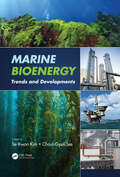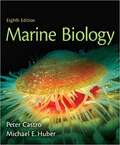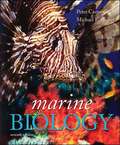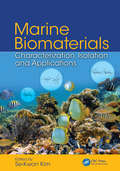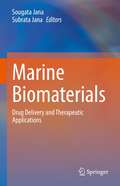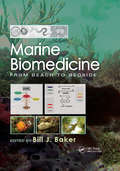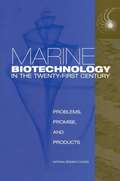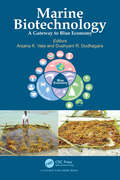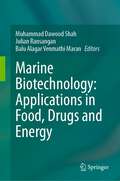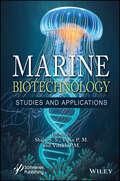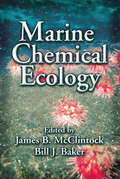- Table View
- List View
Marine Bioenergy: Trends and Developments
by Se-Kwon Kim Choul-Gyun LeeMarine Bioenergy: Trends and Developments features the latest findings of leading scientists from around the world. Addressing the key aspects of marine bioenergy, this state-of-the-art text:Offers an introduction to marine bioenergyExplores marine algae as a source of bioenergyDescribes biotechnological techniques for biofuel productionExplains th
Marine Biofouling: Colonization Processes and Defenses
by Alexander I. RailkinRecent instances of bioinvasion, such as the emergence of the zebra mussel in the American Great Lakes, generated a demand among marine biologists and ecologists for groundbreaking new references that detail how organisms colonize hard substrates, and how to prevent damaging biomass concentrations.Marine Biofouling: Colonization Processes a
Marine Biological Materials of Invertebrate Origin: Invertebrates (Biologically-Inspired Systems #13)
by Hermann EhrlichThe work is a source of modern knowledge on biomineralization, biomimetics and bioinspired materials science with respect to marine invertebrates. The author gives the most coherent analysis of the nature, origin and evolution of biocomposites and biopolymers isolated from and observed in the broad diversity of marine invertebrate organisms and within their unusual structural formations. The basic format is that of a major review article, with liberal use of references to original literature. There is a wealth of new and newly synthesized information, including dozens of previously unpublished images of unique marine creatures and structures from nano- to microscale including high-resolution scanning and transmission electron micrographs. The material is organized effectively along both biological (phyla) and functional lines. The classification of biological materials of marine origin is proposed and discussed. Much of the pertinent data is organized into tables, and extensive use is made of electron micrographs and line drawings. Several modern topics e.g. “biomineralization- demineralization-remineralization phenomena”, or “phenomenon of multiphase biomineralization”, are discussed in details. Traditionally, such current concepts as hierarchical organization of biocomposites and skeletal structures, structural bioscaffolds, biosculpturing, biomimetism and bioinspiration as tools for the design of innovative materials are critically analyzed from both biological and materials science point of view using numerous unique examples of marine origin. This monograph reviews the most relevant advances in the marine biomaterials research field, pointing out several approaches being introduced and explored by distinct laboratories.
Marine Biologist (Cool Cutting Edge Careers)
by William David ThomasAre you interested in ocean plants and animals? Have you ever wondered how pollution affects the underwater world? Do you enjoy being in the water? Do you like hands-on research and technology? Then you might have a future as a marine biologist! Swim along with real-life marine biologists and learn what its like to study life in the sea.
Marine Biology
by Michael E. Huber Peter Castro William C. Ober Claire W. GarrisonMarine Biologycovers the basics of marine biology with a global approach, using examples from numerous regions and ecosystems worldwide. This introductory text includes solid basic science content needed in a general education course, including the fundamental principles of biology, the physical sciences, and the scientific method. This science coverage is integrated with a stimulating, up-to-date overview of marine biology. Visit the OnlineLearning Center
Marine Biology
by Michael E. Huber Peter Castro William C. Ober Claire W. GarrisonThis fifth edition covers the basics of marine biology and takes a global, non-regional perspective to emphasize that the world' s oceans and seas are an integrated system that cannot be understood by looking in any one person's own backyard. For many students this is a new perspective. One aspect of this global approach is the deliberate inclusion of examples from many different regions and ecosystems so that as many students as possible, not just in North America but around the world, will find something relevant to their local areas or places they have visited. This introductory, one-semester text is designed for non-majors.
Marine Biology
by Jeffrey LevintonLevinton's Marine Biology is highly acclaimed and regarded by many as the best, most authoritative text for the sophomore/junior/senior marine biology course. The text is characterized by its exceptionally clear and conversational writing style, comprehensive coverage, and sophisticated presentation featuring organismal and ecosystem ecology topics from an evolutionary perspective. Over the course of five editions, Jeff Levinton has balanced his organismal and ecological focus by including the latest developments from the world of molecular biology, global climate change, and oceanic processes.
Marine Biology
by Karen Bush GibsonWhy is Earth called the Blue Planet? Because there’s so much water on the surface that the planet looks blue from outer space! Marine biology is the study of the plant and animal life in salt water environments, from microscopic plankton to the largest animal on earth, the blue whale. In Marine Biology: Cool Women Who Dive readers ages 9 to 12 explore the careers of three women who work within the science of marine biology--Natalie Arnoldi, Ashanti Johnson, and Lauren Mullineaux. Nomad Press books in the Girls in Science series supply a bridge between girls’ interests and their potential futures by investigating science careers and introducing women who have succeeded in science. Compelling stories of real-life scientists provide readers with role models that they can look toward for examples of success. Marine Biology uses engaging content, links to primary sources, and essential questions to whet kids’ appetites for further exploration and study. This book explores the history of marine biology, the women who made key discoveries, and the multitude of varied careers in this exciting and important field. Marine Biology encourages both boys and girls to envision what lies beneath the miles of water that make up our planet.
Marine Biology
by Michael E. Huber Peter CastroThis fifth edition covers the basics of marine biology and takes a global, non-regional perspective to emphasize that the world's oceans and seas are an integrated system that cannot be understood by looking in any one person's own backyard. For many students this is a new perspective. One aspect of this global approach is the deliberate inclusion of examples from many different regions and ecosystems so that as many students as possible, not just in North America but around the world, will find something relevant to their local areas or places they have visited. This introductory, one-semester text is designed for non-majors.
Marine Biology
by Peter Castro; Michael E. HuberMarine Biology covers the basics of marine biology with a global approach, using examples from numerous regions and ecosystems worldwide. This introductory, one-semester text is designed for non-majors. Authors Castro and Huber have made a special effort to include solid basic science content needed in a general education course, including the fundamental principles of biology, the physical sciences, and the scientific method. This science coverage is integrated with a stimulating, up-to-date overview of marine biology.
Marine Biology (7th edition)
by Michael E. Huber Peter CastroMarine Biology, seventh edition provides a rigorous introduction to marine biology as a science and reinforces and enhances readers' enchantment with marine life. This edition adopts a global perspective to emphasize that the world's oceans and seas are an integrated system that cannot be understood by looking in any one person's own backyard.
Marine Biology (AP Marine Biology Series)
by Peter Castro Michael HuberMarine Biology covers the basics of marine biology with a global approach, using examples from numerous regions and ecosystems worldwide. <p><p>This introductory text includes solid basic science content needed in a general education course, including the fundamental principles of biology, the physical sciences, and the scientific method. This science coverage is integrated with a stimulating, up-to-date overview of marine biology. includes print student edition
Marine Biology: A Functional Approach to the Oceans and their Organisms (Marine Science Series)
by Jerónimo PanWe present you with an updated reference book aimed for upper-level undergraduate and graduate students interested in Marine Biology. The textbook is designed to introduce the fundamentals of marine organisms and their ecological roles in the world’s oceans, and is organized by functional groups, emphasizing marine biodiversity rather than systematics or habitats. Each chapter has been written and peer-reviewed by renowned international experts in their respective fields, and includes updated information on relevant topics, from the microbial loop and primary production in the oceans, to marine megafauna and the impacts of projected climate change on marine life and ecosystems.
Marine Biology: An Introduction to Ocean Ecosystems (Second Edition)
by Amy Sauter HillTips on preparing and setting up each of the labs - A list of aquariums, marine-science centers, web sites, and other helpful teaching resources - Tried-and-true methods to ensure that students get the most from every lab and project See the companion Marine Biology lab manual and Marine Biology student book.
Marine Biology: Cool Women Who Dive
by Karen Bush Gibson Lena ChandhokWhy is Earth called the Blue Planet? Because there's so much water on the surface that the planet looks blue from outer space!Marine biology is the study of the plant and animal life in salt water environments, from microscopic plankton to the largest animal on earth, the blue whale. In Marine Biology: Cool Women Who Dive readers ages 9 to 12 explore the careers of three women who work within the science of marine biology-Natalie Arnoldi, Ashanti Johnson, and Lauren Mullineaux.Nomad Press books in the Girls in Science series supply a bridge between girls' interests and their potential futures by investigating science careers and introducing women who have succeeded in science. Compelling stories of real-life scientists provide readers with role models that they can look toward for examples of success.Marine Biology uses engaging content, links to primary sources, and essential questions to whet kids' appetites for further exploration and study. This book explores the history of marine biology, the women who made key discoveries, and the multitude of varied careers in this exciting and important field. Marine Biology encourages both boys and girls to envision what lies beneath the miles of water that make up our planet.
Marine Biology: Function, Biodiversity, Ecology
by Jeffrey LevintonWith its clear and conversational writing style, comprehensive coverage, and sophisticated presentation, Marine Biology: Function, Biodiversity, Ecology, Fifth Edition, is regarded by many as the most authoritative marine biology text. <P><P>Over the course of five editions, Jeffrey Levinton has balanced his organismal and ecological focus by including the latest developments on molecular biology, global climate change, and ocean
Marine Biomaterials: Characterization, Isolation and Applications
by Se-Kwon KimOceans are an abundant source of diverse biomaterials with potential for an array of uses. Marine Biomaterials: Characterization, Isolation and Applications brings together the wide range of research in this important area, including the latest developments and applications, from preliminary research to clinical trials. The book is divided into fou
Marine Biomaterials: Drug Delivery and Therapeutic Applications
by Sougata Jana Subrata JanaThis book is focused on marine based biomedical carriers for delivery of therapeutics. Marine biomaterials and bio-based carriers show wide applications in pharmaceutical as well as biomedical fields for delivery of small and large molecules. Biomaterial-based composites, scaffolds or matrix systems are promising systems for controlled and prolonged release of drug in target site and control the premature release of drugs or bioactive compounds. This book discusses the targeted delivery of drugs and therapeutic applications. It also describes the use of marine biopolymers in cancer therapy. Different chapters describe the tissue engineering techniques to develop these carriers. The marine biomaterial-based systems are widely used for tissue engineering, and biomedical imaging. This book is meant for industry experts, students and researchers in the area of pharmaceutical sciences, biomedical engineering and material science and pharmacology.
Marine Biomedicine: From Beach to Bedside
by Bill J. BakerMarine Biomedicine: From Beach to Bedside assesses current efforts in marine biomedicine and evaluates the implications of recent advances on the future of the field.Richly illustrated in full color to enhance reader comprehension, the book covers four sections. The first one addresses the technology that has recently been brought to bear on the st
Marine Bioprospecting for Sustainable Blue-bioeconomy
by Naga Raju Maddela Sesan Abiodun Aransiola Olabisi Peter Abioye Abayomi BamisayeThis volume comprehensively discusses marine bioprospecting and its applications in the marine bioeconomy, specifically in clean energy generation, and in biomedical, industrial and agricultural sectors. The advent of modern technology, particularly advancements in deep-sea exploration and biotechnology, has enabled scientists to delve deeper into the ocean's depths and discover a treasure trove of unique organisms and compounds. This demonstrates that the rich history of human interactions with the oceans is firmly ingrained in marine bioprospecting. The blue-economy, which is a more accurate name for the systematic search for valuable substances and organisms in the water, has gained popularity in recent years as a possible route for sustainable economic development. One of the key driving factors behind marine bioprospecting is the growing realization that marine organisms possess unique biochemical compounds with the potential to revolutionize various industries. These compounds include novel enzymes, antimicrobial agents, bioactive molecules, and even potential pharmaceuticals. Readers will learn about the applications of these discoveries in bioremediation, wastewater treatment, and biofuel production, as well as the identification of natural substitutes for things that are detrimental to the environment, which include biodegradable plastics derived from marine microorganisms. The primary audience for the book will be governmental and international organizations, professionals, and economists, while the secondary audience will be professors and researchers in the fields of Chemistry, Biotechnology, Environmental Microbiology, and general Ocean Sciences.
Marine Biotechnology In The Twenty-first Century: Problems, Promise, And Products
by Committee on Marine Biotechnology: Biomedical Applications of Marine Natural ProductsDramatic developments in understanding the fundamental underpinnings of life have provided exciting opportunities to make marine bioproducts an important part of the U.S. economy. Several marine based pharmaceuticals are under active commercial development, ecosystem health is high on the public's list of concerns, and aquaculture is providing an ever greater proportion of the seafood on our tables. Nevertheless, marine biotechnology has not yet caught the public's, or investor's, attention. Two workshops, held in October 1999 and November 2001 at the National Academies, were successful in highlighting new developments and opportunities in environmental and biomedical applications of marine biotechnology, and also in identifying factors that are impeding commercial exploitation of these products. This report includes a synthesis of the 2001 sessions addressing drug discovery and development, applications of genomics and proteomics to marine biotechnology, biomaterials and bioengineering, and public policy and essays contributed by the workshop speakers.
Marine Biotechnology: A Gateway to Blue Economy
by Anjana K. Vala Dushyant R. DudhagaraThe marine environment has always been beneficial to mankind in one way or another. With advancements in scientific knowledge and technological development, novel aspects of marine resources have been and are being revealed that can be harnessed for sustainable development of blue economy. The book Marine Biotechnology: A Gateway to Blue Economy is an attempt to present before the scientific community, a compilation of recent developments in the field of marine biotechnology contributed by leading scientists of international repute. The book covers diverse roles of marine biotechnology, including in agriculture, probiotics, health sector, novel biomolecules, biochemicals, biomedicine, and pharmaceuticals.
Marine Biotechnology: Applications in Food, Drugs and Energy
by Muhammad Dawood Shah Julian Ransangan Balu Alagar Venmathi MaranThis contributed volume covers the applications of marine biotechnology for food, drugs and energy production using marine resources. It introduces many aspects of marine biotechnology, including bioenergy, pharmaceutical development, food security from mariculture, pollution handling, legal issues and conflicts. Information in the book is accompanied by clear images, flow charts, quantitative and qualitative data. Marine biotechnology is essential for realizing the previously untapped potential of marine bio-resources. These resources are used to develop innovative goods and procedures that aid in the global management of food, energy, and disease management. The development of innovative tools and solutions for more sustainable marine environmental management is another important section of this title. This reference book is of interest to teachers, researchers, and climate change scientists. It serves as an additional reading material for college, undergraduate, and graduate students of marine science and aquaculture. This is also a good research guide for food and fishing industry scientists.
Marine Biotechnology: Studies and Applications (Marine Sciences and Technology)
by Visakh. P. M. Shaju S. S. Vipin. P. M.Discover the cutting-edge field of marine biotechnology with this comprehensive guide, offering expert insights and real-world case studies demonstrating its wide range of applications. Marine biotechnology is a cutting-edge field leading to a more sustainable future through the extraction of biocompounds. This book introduces the fundamentals of marine biotechnology and its applications. Through expert insights and real-world case studies, the book serves as a comprehensive guide for a wide range for concepts, including the evolution of marine biotechnology and biodiscovery, bio-molecular components extracted from marine bioresources, and biotechnological advances to extend the use of marine bioresources for industrial and agricultural applications. This book is an essential resource for beginners and seasoned professionals looking towards the future of marine biotechnology. Readers will find this volume: Presents real-world studies and applications to demonstrate the evolution of marine biotechnology and biodiversity; Provides in-depth explorations of niche concepts, such as bioprospecting of natural products from marine phytoplanktons, pharmaceutical and nutraceutical applications of marine micro-algae, and the application of marine gelatin and chitosan edible nanocomposite film for food coating and packaging; Explores methods to help researchers find solutions to both fundamental and applied problems in the area of marine biotechnology. Audience Marine scientists, aquaculture technologists, marine engineers, and academics interested in the cutting-edge applications of marine biotechnology.
Marine Chemical Ecology (CRC Marine Science)
by Bill J. Baker James B. McClintockThe interdisciplinary field of marine chemical ecology is an expanding and dynamic science. It is no surprise that the breadth of marine organisms studied expanded in concert with developments in underwater technology. With its up-to-date subject reviews by experts, Marine Chemical Ecology is the most current, comprehensive book on the subject. The
